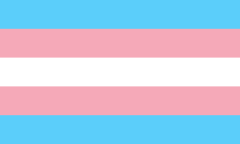
Back Transgender Afrikaans Transgeschlechtlichkeit ALS Transchenero AN تحول جنسي Arabic ট্ৰান্সজেণ্ডাৰ Assamese Tresxéneru AST Transgender Azerbaijani Трансгендарнасць Byelorussian Трансджендър Bulgarian রূপান্তরিত লিঙ্গ Bengali/Bangla
 | |
| Classification | Gender identity |
|---|---|
| Abbreviations | |
| Subcategories | |
| Symbol | |
| Other terms | |
| Associated terms | |
| Part of a series on |
| Transgender topics |
|---|
|
|
| Part of a series on |
| LGBTQ topics |
|---|
|
|
A transgender person (often shortened to trans person) is someone whose gender identity differs from that typically associated with the sex they were assigned at birth.[1]
Often, transgender people desire medical assistance to medically transition from one sex to another; those who do may identify as transsexual.[2][3] Transgender does not have a universally accepted definition, including among researchers;[4] it can function as an umbrella term. The definition given above includes binary trans men and trans women and may also include people who are non-binary or genderqueer.[5][6] Other related groups include third-gender people, cross-dressers, and drag queens and drag kings; some definitions include these groups as well.[5][7]
Being transgender is distinct from sexual orientation, and transgender people may identify as heterosexual (straight), homosexual (gay or lesbian), bisexual, asexual, or otherwise, or may decline to label their sexual orientation.[8] The opposite of transgender is cisgender, which describes persons whose gender identity matches their assigned sex.[9] Accurate statistics on the number of transgender people vary widely,[10] in part due to different definitions of what constitutes being transgender.[4] Some countries, such as Canada, collect census data on transgender people.[11] Generally, less than 1% of the worldwide population is transgender, with figures ranging from <0.1% to 0.6%.[12][13]
Many transgender people experience gender dysphoria, and some seek medical treatments such as hormone replacement therapy, gender-affirming surgery, or psychotherapy. Not all transgender people desire these treatments,[14] and some cannot undergo them for legal,[15] financial,[16] or medical[17] reasons.
The legal status of transgender people varies by jurisdiction. Many transgender people experience transphobia (violence or discrimination against transgender people) in the workplace,[18] in accessing public accommodations,[19] and in healthcare.[20] In many places, they are not legally protected from discrimination.[21][page needed] Several cultural events are held to celebrate the awareness of transgender people, including Transgender Day of Remembrance and International Transgender Day of Visibility,[22][23] and the transgender flag is a common transgender pride symbol.[24]
- ^ APA 2018.
- ^ Bevan 2014. "The term transsexual was introduced by Cauldwell (1949) and popularized by Harry Benjamin (1966) [...]. The term transgender was coined by John Oliven (1965) and popularized by various transgender people who pioneered the concept and practice of transgenderism. It is sometimes said that Virginia Prince (1976) popularized the term, but history shows that many transgender people advocated the use of this term much more than Prince." Referencing Oliven 1965, p. 514.
- ^ Polly & Nicole 2011, p. 57. "The use of terminology by transsexual individuals to self-identify varies. As aforementioned, many transsexual individuals prefer the term transgender, or simply trans, as it is more inclusive and carries fewer stigmas. There are some transsexual individuals, however, who reject the term transgender; these individuals view transsexualism as a treatable congenital condition. Following medical and/or surgical transition, they live within the binary as either a man or a woman and may not disclose their transition history."
- ^ a b Britannica 2024.
- ^ a b Franklin 2014, p. 740. "Transgender is an umbrella term for people whose gender identities, gender expressions, and/or behaviors are different from those culturally associated with the sex that they were assigned at birth. Transgender encompasses a wide variety of identities including, but not limited to, transsexual, genderqueer, bi-gender, third gender, cross-dresser, and drag king/queen."
- ^ GLAAD n.d.
- "An adjective to describe people whose gender identity differs from the sex they were assigned at birth" (¶ "Transgender").
- "Many nonbinary people also call themselves transgender and consider themselves part of the transgender community" (¶ "Nonbinary People").
- ^ Variously:
- Petersen & Hyde 2010, p. 486. "Transgender is a broad term characterized by a challenge of traditional gender roles and gender identity [...] For example, some cultures classify transgender individuals as a third gender, thereby treating this phenomenon as normative."
- Towle & Morgan 2013, p. 666. "The authors note that, increasingly, in social science literature, the term third gender is being replaced by or conflated with the newer term transgender."
- Reisner et al. 2014, p. 99. "Transgender was defined broadly to cover those who transition from one gender to another as well as those who may not choose to socially, medically, or legally fully transition, including cross-dressers, people who consider themselves to be genderqueer, androgynous, and those whose gender nonconformity is a part of their identity."
- ^ CDC 2020.
- ^ Blank 2014.
- ^ GEO 2018.
- ^ Easton 2022.
- ^ M.H. 2017.
- ^ UCSF n.d.
- ^ Lamm & Eckstein 2015, p. 745. "Many transgender people experience gender dysphoria – distress that results from the discordance of biological sex and experienced gender. Treatment for gender dysphoria, considered to be highly effective, includes physical, medical, and/or surgical treatments [...] some [transgender people] may not choose to transition at all."
- ^ AP 2024.
- ^ Johnson et al. 2019.
- ^ Klein, Paradise & Goodwin 2018.
- ^ Lombardi et al. 2008.
- ^ Dallara 2011.
- ^ Bradford et al. 2013.
- ^ Whittle 2002.
- ^ Sudborough 2022.
- ^ CBC 2013.
- ^ Ford 2014.